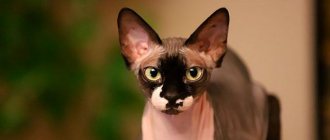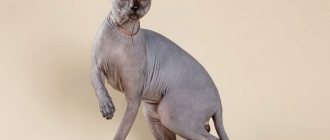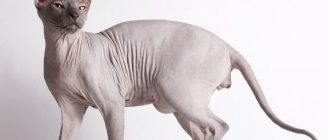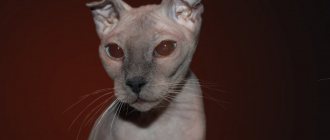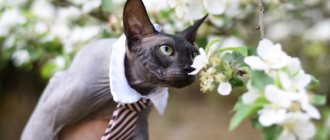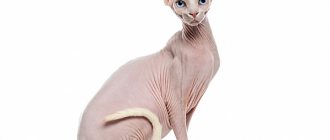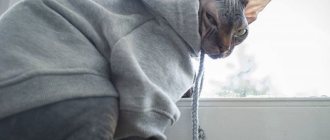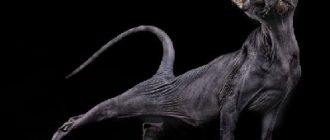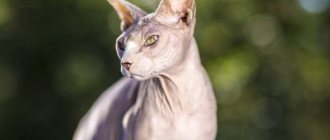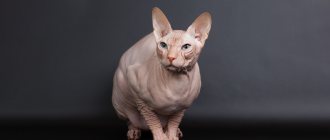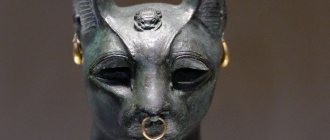Why was the Sphynx born with fur?
Sometimes, new owners of Sphynx kittens are concerned with the question of why their Sphynx was born with fur and whether it is likely that he will go bald and become a full-fledged representative of his breed?
Firstly, there is no need to “panic” ahead of time. Having fur in kittens can be completely normal.
For example, among the Don Sphynxes, three varieties can be distinguished: brush, velor and bare-born. With the exception of bareborns, who have no hair or whiskers at all (read about the reason for the lack of whiskers in sphinxes in the article “Why sphinxes do not have whiskers”), kittens have short hair, which they lose as they grow up to one year.
The brush (from English “Brush” - “brush”) is characterized by the presence of short, hard wool, which is often compared to felt boots. Velor kittens can be born with fluff.
As a rule, the fur sheds over time, but may remain on the paws, tail and head.
During the cold season there may be more wool.
Reasons for the presence of fur in sphinxes:
The breed is not purebred . If someone from their parents (and in general, in the family) was not hairless, perhaps their genes played a role. Sometimes it even happens that unscrupulous breeders shave such kittens and pass them off as “pure” Sphynx cats. Hormonal imbalances . There have been cases when, after castration or sterilization, the Sphynx's fur began to grow.
Let your favorite Sphynx cat be naked!
More information on Why was the Sphynx born with fur?
You can receive by leaving a comment.
Source
At what month does a Sphynx cat lose all its hair?
Currently, there are three intra-breed varieties: barebred (rubber), velor “flocked” (with rudimentary hairs all over the body) and “brush” (with thick wavy and very soft hair or with hard, crimped, almost broken hair). One litter can produce both bare-born and “brush” kittens and velor kittens. If at birth a bald spot (“tonsure”) appears on the crown of the kittens of the last two types, then over time these kittens will shed their hair and turn into true sphinxes. How quickly this will happen can be determined at the age of 1-2 months. If the coat remains fine and silky at this age, the kitten will “undress” at about 4-5 months. If the coat is harsh to the touch, shedding the coat can take up to 1.5-2 years. However, the process of “undressing” is individual for each animal.
Naked and velor varieties of Don Sphynxes compete for titles and are successfully exhibited at various exhibitions. Brushes may be exhibited without the right to receive titles. At the same time, they are very actively used in breeding, especially when paired with naked-born. Some “brushes”, after reaching puberty, begin to intensively shed their hair and become completely hairless, with the exception of the limbs, on which short, soft and slightly wavy hair remains. Such animals can also be exhibited at exhibitions, they receive titles.
Sphynx cats with fur: do they exist, what are they called and why does this happen?
The appearance of hairless sphinxes in the last century frightened and delighted people. Many did not understand how one could fall in love with a hairless cat. After all, this animal should be soft and fluffy, pleasant to the touch, a real antidepressant.
Some twenty years have passed, and attitudes towards sphinxes have changed. If you get this breed, you expect a complete lack of hair. The Internet is replete with indignation like: “I bought a Sphynx, but its fluff is growing, what should I do? Maybe he’s not a sphinx?
You don’t need to do anything - just love the animal. Sphynxes come in different varieties, and the presence of fur on some species is normal . To understand whether sphinxes have hair, we will give a description of some species of this animal.
Don Sphynx
At the end of the eighties of the last century, the first hairless cat was born in Rostov-on-Don. From her the Don breed of sphinxes began. In the Don breed, baldness is caused by the presence of the dominant Hbl allele in the genotype. There are four main groups of this type: naked, flock, velor, brush.
Holoborn ("rubber")
The name speaks for itself - kittens are born without a hint of fur. Moreover, they may lack mustaches and eyebrows, as well as sensitive hairs on their paws. The skin of such animals resembles rubber or plasticine; it is warm, sticky, with a large number of folds on the head and body. Babies can be born with their eyes open, as is the case in humans.
The elastic, thin skin does not yet have its final color. The future color of the animal (blue, black, spotted) can be recognized by the pads on its paws. Some individuals grow sparse fur in winter, but it disappears in spring.
Larger animals remain naked with many folds throughout their lives. They are of great interest to breeders.
Kittens are born with barely noticeable fluff all over their skin, like peaches. The tactile sensations from touching their skin are very pleasant and unusual; cats resemble plush toys. By the age of two, the hair becomes thinner, the hair follicles die off, and the animals become completely bald.
Velours
Velor, like flock, only visually looks bald - when you take the kitten in your hands, you feel soft fluff all over the body, like lint on velor fabric. Unlike flock, the hair on this type of animal is longer and thicker, especially on the face, paws and tail. The top of the head remains completely bald. By stroking your baby against the grain, you can notice how quickly his even hair is restored.
Velor kittens are divided into types based on the condition of their coat. Lightweight - has a minimum hair length of two millimeters. They are thicker on the paws than on the body. Some kittens have coarse hair, others have soft hair. There is no hair on the top of the head.
Description of the breed
Since we mentioned three types of sphinxes at the very beginning, it would be most logical to consider the characteristics of each of them. Let's start with Canadians, who can be distinguished from other breeds according to existing standards:
- the head is wedge-shaped, medium in size, with prominent cheekbones and mustache pads;
- Muscles are clearly visible on the body and limbs, but this does not prevent sphinxes from being graceful and sophisticated cats. They also have a cute round belly;
- very large eyes, shaped like a lemon;
- the ears are large, rounded at the ends, set high on the head;
- one of the characteristic features of this breed is thickened pads on its paws, which create the appearance that the cat has an additional sole or heels;
- a long, hairless tail, although some cats have a tuft of wool growing at the tip;
- The skin should be given special attention. Little Canadians have a lot of folds on it, which makes them look like they tried on a size too big. With age, the folds smooth out a little. By the way, Canadian Sphynxes are considered to be the most folded cats without hair. If we talk about the presence of a “gun,” then it can be present on the paws, bridge of the nose, tail and ears. There are also sphinxes whose entire body is covered with such fluff; when touched, they resemble a delicate peach.
Canadian Sphynx
The history of the Canadian Sphynx began twenty years earlier than the Don Sphynx, when in 1966 a hairless kitten was born to a domestic cat in Canada. Such phenomena have occurred before, among different nations, but babies without fur were considered a mutation and were discarded. Only the Canadian kitten interested breeders and became the progenitor of a new breed, which is called Sphynxes all over the world. In Russia, the word “Canadian” was added to the name so as not to be confused with Don and St. Petersburg.
Unlike the Don species, the mutation of the Canadian species is expressed by a recessive baldness gene. Most often, sphinxes retain thin remnants of hair behind the ears, on the tail, limbs or on the nose even into adulthood.
A slightly perceptible fuzz of the skin gives the feeling of suede. With age, the pile may become thicker.
History of the breed
According to some sources, cats without fur lived back in the times of the Aztecs. However, the first accurate confirmations appeared in the last century. Then, at exhibitions in the United States, a special breed was demonstrated - the Mexican Hairless, whose representatives, unfortunately, never acquired offspring, which is why this species simply disappeared. Judging by the description, they had significant differences from modern sphinxes: the body was quite long, the head had a wedge-shaped head, the eyes had a bright amber hue, and there were mustaches on the muzzle, which are not found in modern breeds. By winter, hair grew on their back and tail, which disappeared by summer.
The genetic code of these four-legged animals was never solved, so the breed sank into oblivion. However, in 1966, a furless kitten was born in Canada and was named Prune. As soon as he grew up, they began to cross him with his “relatives” in order to preserve the original genetic chain. However, attempts to develop a new breed failed because the genes turned out to be very unstable and kittens with fur still appeared in the litter. In addition, hairless kittens required special care, without which they quickly died.
However, 10 years later the decision came by itself, when a hairless cat named Epidermis was born in one of the American nurseries. A year later, a cat was born in the same place, who became the “bride” of Epidermis. It was thanks to them that breeders finally managed to breed sphinxes.
In our country, the first Canadian Sphynxes appeared in the early 2000s, but it is impossible to say that it was then that the first hairless cats were brought to Russia. The fact is that in 1987, a kitten was found on the street of Rostov-on-Don, which was completely missing hair. No, don’t think about it - it was not an illness. It turns out that he, like his Canadian counterparts, had a mutation due to which there was not a hair on his body. Subsequently, this breed received the name Don Sphynx, so the appearance of hairless Canadian cats was no longer something unusual and outlandish for Russians.
And already in 1994, in St. Petersburg, breeders decided to cross an Oriental cat with the Don Sphynx, thanks to which hairless Orientals were born - the Peterbald.
Differences between the Canadian and Don Sphynx
Cats without fur, with a lot of folds, look like aliens. They are all called Sphynxes, and not everyone knows that this breed has its own species that differ from each other. Canadian and Don Sphynxes have the following differences:
- species have different baldness genes (dominant and recessive); Canadian Sphynxes are always covered with barely noticeable fluff, and Don Sphynxes can be completely hairless (“rubber”); Canadian individuals are endowed with large round eyes, while Don individuals have an almond-shaped eye shape; Canadians have no mustache at all; in the Don species, the tail is of medium length and thickness, straight and rather strong, in contrast to the Canadians, whose tail is weak, thin and pointed at the end; Don individuals have a strong torso and a strong muscular system, in contrast to the underdeveloped muscles of Canadians.
Petersburg Sphynx (Peterbald)
The breed was bred in St. Petersburg in 1994. Baldness is based on a recessive gene. The ancestors of the species were the Don Sphynxes. This breed is distinguished by an elegant, slender appearance, an elongated muzzle with oval eyes and huge ears set apart to the sides.
In addition to animals without hair, Peterbalds, like the Don Sphynx, have varieties of individuals with wool: brush, velor, flock, straight-haired. Let's focus on the last variety, since the previous types were considered in the review of the Don breed.
Tendency to diseases
Don Sphynx cats are predisposed to the following genetic diseases:
- congenital entropion of the eyelids (treated surgically);
- microphthalmos - reduction in the size of the eyeball (vision deteriorates);
- syndrome of “falling asleep kittens” (due to underdevelopment of the thymus gland, babies die);
- curvature of the caudal spine, causing a number of other pathologies (problems of the skeletal system, underdevelopment of the intestines, etc.);
- nipple hyperplasia in cats (if drugs to suppress sexual desire were used);
- undershot - shortening of the lower jaw (affects quality of life);
- skin vasculitis (inflammation of the vascular walls of the skin).
Most often, Don people have skin problems caused by excessive production of sebaceous glandular secretions. These may be the following diseases:
- dermatitis;
- eczema;
- trichophytosis;
- acne.
Absolutely naked individuals are susceptible to skin diseases more often than those with fur.
Straight-haired
The basis of the species is the selection of Siamese and Oriental cats with Sphynxes. These animals do not have the baldness gene; they have normal fur and mustaches. The coat is short, close to the body, of the oriental type. The color of the Peterbald often repeats the color of its ancestors - the Siamese and Oriental groups.
pros
Many owners note the friendly and easy-going nature of Sphynx cats with fur. Cats of this breed have the following advantages:
- lack of aggression;
- high intelligence;
- learning ability;
- good harmony with other species of animals;
- pickiness in food;
- cleanliness.
In addition, Sphynx cats with fur are considered healing cats. They have increased heat exchange, and the surface of the hair always remains hot. These animals can be used as living heating pads. They are extremely affectionate and love to cuddle up to the human body.
Why do sphinxes have fur?
The appearance of new hair on an animal of this breed, or, conversely, its disappearance after the woolly kittens grow up, is associated with many factors. There will be no clear answer. The reasons may be the following:
- The appearance of hairiness is sometimes influenced by vaccinations; hormonal manifestations of the individual associated with bearing kittens; unsuccessful selection of feed; weather; castration.
If a litter has ideal parents, but one of the kittens was still born with hair, do not forget that he had great-grandparents who gave the baby hair.
In the end, the lack of fur only reduces the price of a kitten, but does not in any way affect its character, which is sweet and good-natured, like all sphinxes.
Care
Since these purrs have non-standard hair, caring for them has some features. They have an elevated body temperature - approximately forty to forty-one degrees.
To read: Features of the Corgi Fluffy breed, reviews from owners
Therefore, they get sunburn easily. It is important not to let them spend too much time under the hot rays. The room should be warm and drafts should be avoided. When walking outside, it is important to ensure that the animal does not get wounded, because their skin is especially sensitive. It’s better not to let them out of the apartment at all.
Every day the animal needs to be wiped with water because it sweats. Once every seven days you are supposed to bathe him using a special shampoo. It is worth feeding a cat with premium food; many veterinarians do not recommend natural food. The creature has a fast metabolism, so it eats a lot. This is normal, due to this his immunity is strengthened. Cats love to try new things, like fruit. It is worth trimming your pet's claws and cleaning your pet's ears and teeth regularly. Buy him new toys, invent games, because otherwise he will be bored.
These cats live for about fifteen years, this figure is greatly influenced by nutrition. Sometimes it can change, the main factors influencing it are heredity, immunity and care.
To exclude diseases, you should regularly visit the veterinarian, get all the necessary vaccinations and give your pet vitamins. In the fall, it is important to dress him in special clothes, which are sold in pet stores. In winter, place a pad on the radiator, because the cat loves to bask there and can burn the delicate skin.
Interesting things about sphinxes
- The hypoallergenic nature of Sphynx dogs is a myth. Even in the absence of fur, the body of overly sensitive people can react to the animal’s sweat and salivation. Sphynxes stand out among the cat family not only for their fantastic appearance, but also for their canine character: kind, loyal, attached to their owner. Cats of this breed get along easily with any pet, but if they were allowed to choose companions, they would prefer Sphynx cats. Sphynxes have a high heat output, so they love to eat heavily - only a fast metabolism saves them from obesity. Before the breed became known, owners tried to treat mutated hairless kittens for lichen. Cats love to sleep with their owners under the blanket, with their head on the pillow. Sphynx cats can sunbathe and sweat just like humans. Representatives of this breed live up to fourteen years, although there are cases where pets lived up to the age of nineteen.
Sphynxes are unusual animals, they have a distinctive appearance, good intelligence and friendliness, that is, everything you need to make an excellent pet and good friend.
You will learn more about Sphynx cats with fur in the following video.
Source
Reviews
All owners of such tailed animals are very happy with them, it is impossible not to fall in love with them; as a rule, such pets become loved by all family members, even if someone is initially put off by their appearance. Cats of this variety are disciplined, easy to train and raise, and love to be photographed.
They are loyal and love their owners, meeting them at the doorstep and following them around the house everywhere. They often sleep in bed with people, love to purr on their knees and sleep in the warmth of human hugs.
To read: Spanish Mastiff ca de bo: an active and strong-willed fighting pet
Some take in adult animals, and they still quickly adapt to the new environment. They love children and easily find a common language with other representatives of the animal world. They do not spoil wallpaper and furniture, especially if you accustom them to scratching posts from childhood. They always go to the toilet in the litter box. The only thing that can be a problem for busy people is daily wiping, but for those who are already used to it, caring for a cat is a pleasure.
